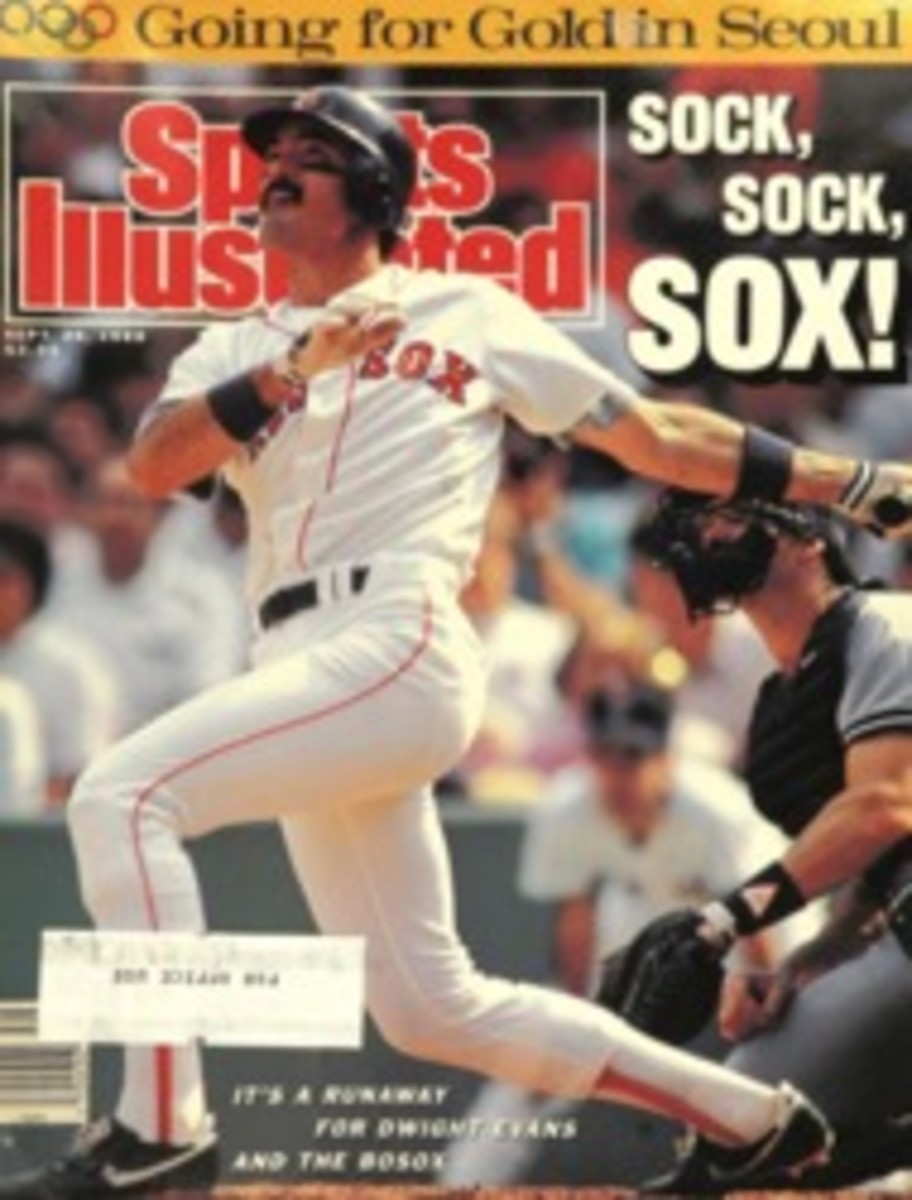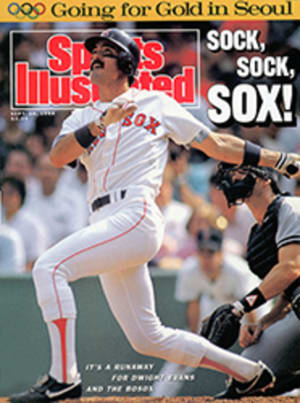
A HURDLER'S GOLDEN OPPORTUNITY
In the fall of 1941, as freshmen registered at colleges across the land, and the U.S. edged toward World War II, nobody could say when the next Olympic Games would take place. The 1940 Games had been scratched, and the prospects for 1944 were growing dim.
Nevertheless, there was no curbing the Olympic enthusiasm of Eddie Finnigan, a glib and inspirational teacher of physical education at Baldwin-Wallace College in Berea, Ohio. To anyone who would listen, including his newspaper boy—me—Finnigan promised that among the next crop of Olympic gold medalists would be the new kid in town, William Harrison (Bones) Dillard, whom the persuasive Finnigan had intercepted almost at the gates of Ohio State University. Finnigan, who coached Baldwin-Wallace's nondescript track team, had somehow lured Dillard, the state schoolboy hurdling champ from East Technical High in Cleveland, away from Ohio State.
Dillard, now 65, remembers the late Finnigan as being "sincere in his belief in me. And I liked Berea's small-town atmosphere. It was also much closer to home than Ohio State, and a couple of friends from Tech were going there." This altered Dillard's boyhood dream of emulating his hero, Jesse Owens, an East Techer who leapt from OSU to Olympic renown. Perhaps Dillard, for whom nobody but Finnigan predicted greatness, was also intimidated by the thought of shadowing Owens. Berea, a residential island surrounded by farmland, 10 miles southwest of Cleveland, seemed calmer than Columbus.
There were few blacks among Baldwin-Wallace's 1,600 students, and Dillard was easily recognized by the neighborhood kids. We were thrilled when he returned a "Hi, Harrison" with a "Hi" and a smile of his own. I would somewhat pompously share with my pals conversations I had had with Finnigan: "Eddie told me Harrison's going to win the Olympics." It was a joy to watch Dillard glide over the hurdles in his T-shirt and gold shorts. Freshmen weren't eligible for varsity competition in those days, but Dillard was beginning to reward Finnigan's confidence with victories in AAU meets and other open competitions.
By the spring of '43 nobody in Ohio college circles could touch Dillard—but the draft board could, and did. Dillard had almost completed his sophomore year when, at 19, the Army nailed him. He had to go, of course, and we moaned about the timing. With only a week or so more of college, he could have finished out the season. But Finnigan, with his blarney and charm, talked the Army into giving 24-hour passes to Dillard and a couple of his other runners. They appeared for the Ohio Conference Championships, a twilight meet on the B-W track. Although stiff from his inoculations, and having missed two weeks of training, Dillard burned up the track in five events, winning the 100-yard dash, the 220, the high and low hurdles, running a leg of the winning 880 relay and giving B-W its first conference title. After that he really was gone, a combat infantryman in Italy.
In 1946 a mature, self-assured Dillard was out of his GI boots and back in the brown-and-gold of Baldwin-Wallace, ready to continue the quest of his and Finnigan's dream. "Bones will take us both to the Olympics. Guaranteed," Finnigan assured me. I was in high school and had progressed from delivering papers to editing and writing the sports page of the local weekly, the Enterprise.
Finnigan was right, although things didn't work out exactly according to his script. After his return, Dillard became the supreme 110-meter hurdler, with victory after victory, record after record, until shortly before the '48 Olympics in London. If anybody was a lock for the U.S. Olympic team and a gold medal, it was the 25-year-old Dillard, the greatest hurdler the world had ever seen, though he trained in a most unlikely setting. During Dillard's era, B-W was, in a way, a one-hurdle college. He practiced for major indoor meets in the ancient sandstone gym, only 90 feet from end to end. To watch him run there was to cringe. "It was 15 yards to the first hurdle—the only hurdle we could set up in the gym," Dillard recalls with a chuckle. He would surge from the blocks, flow over that single barrier and try not to slam into the brick wall. Over and over. "That's how I became such a good starter," he says.
Finnigan was nearly homicidal the afternoon the celebrated photographer, Gjon Mili, showed up to shoot Dillard for LIFE magazine. "Just one more," Mili kept urging after Dillard's regular workout. Dillard repeated the thrust-leap-and-crash routine for almost an hour, while Finnigan barely controlled his rage at the demanding photographer.
Dillard, ever self-effacing, was content to let Finnigan make predictions of victories to come, except for one atypical moment. At a dinner in his honor in Cleveland, shortly before the Olympic trials, Dillard recalled in his speech a similar tribute that had taken place 12 years earlier, when Owens, the spectacularly triumphant Olympian, was welcomed home. A motorcade for Owens had moved from the downtown area through the old neighborhood, and, said Dillard, "Jesse seemed to be waving at me as I stood at the curb at 63rd Street and Central Avenue. That meant everything in the world to me. I ran home and told my mother that I was going to be just like Jesse Owens." Then, perhaps carried away by the occasion, Dillard stepped out of character and pledged that he would "bring a gold medal home to Cleveland."
It seemed an empty promise a few days later at the trials, when the straightaway of Northwestern's Dyche Stadium became his nightmare alley. Dillard, whose 82 straight wins remained the record until Edwin Moses surpassed it in 1983, inexplicably unraveled in the trials. In the 110, he grazed the second hurdle, flattened the next three...and stopped. He didn't even finish the race. He stood for an instant in front of the seventh hurdle, a missed-the-boat look creasing his face, then smiled and trotted to the finish line to congratulate those who had made the team: Clyde Scott, Craig Dixon and the eventual gold medalist, Bill Porter.
Dillard, who had taken up hurdling originally because he wasn't quite as fast in sprints, now says, "T knew that I had beaten those other hurdlers on any number of occasions. Yet there I was, not running my pet event in the Olympic Games. It was awful, but the wound was sort of salved by the fact that I had made the team the day before in the 100. I was at least going to London."
It had seemed incidental. Dean Cromwell, the U.S. coach, had asked Finnigan to enter Dillard in the 100-meter trial, figuring he might place fourth and be eligible to fill out the 400-meter relay team. Dillard finished third, earning a shot at a medal in the 100 as well, but he was certainly not the "world's fastest human," especially alongside world-record holder Mel Patton, Barney Ewell or Lloyd LaBeach of Panama.
What had seemed incidental became all-important. "I envisioned that race and winning it," recalls a still-slim and limber Dillard, who is business manager for Cleveland's board of education. "I was rooming with Ewell, and I told him I was going to beat him. He laughed."
Ewell, who now lives in Lancaster, Pa., recently recalled the 1948 Olympic 100: "Bones got a start the way Ben Johnson does. Fantastic. He was way ahead of us until 70 meters." Then, as Dillard described it: "T lunged forward at the finish and felt the tape strike my chest. Far to the left I see another white jersey do the same. Ewell."
For Dillard followers it was a somber moment, punctuated by Ewell jumping about in joy. Ewell thought he had won, and he convinced the Wembley Stadium crowd that he had, and possibly the judges, too, until they inspected the photo-finish picture. After about five tense minutes came the announcement of the winner: "No. 69...Dillard...United States of America." He had kept that rash after-dinner promise in a wholly improbable manner.
Now, as Dillard stepped up to receive his medal, it was Eddie Finnigan's time to jump and shout. He had kept his 1941 promise about the new kid in town.
PHOTO
GJON MILI/LIFE
While training under Finnigan (left) in a cramped gym, Dillard learned his fast start.
Bud Collins is an NBC-TV tennis analyst and a "Boston Globe" columnist.

